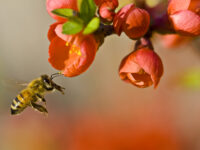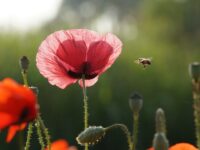But, like so many other animals, these six-legged, exoskeleton-clad creatures are facing a crisis at the hands of human activity.
Our planet is teeming with bugs. Over 1 million insect species are described, and scientists estimate that another four to 7.5 million have yet to be classified. Insects account for a large proportion of animals on Earth and are nearly ubiquitous in terrestrial ecosystems. But, like so many other animals, these six-legged, exoskeleton-clad creatures are facing a crisis at the hands of human activity.
Perhaps the most pressing threat to insects is anthropogenic climate change, or the impact of human actions on the climate. Rising global temperatures have already begun to shift the habitat range of many insects, altering the regions in which different species are capable of surviving. While these changing temperatures are beneficial to some warm-adapted insect species, they ultimately threaten insect biodiversity. Scientists estimate that a global temperature increase of 3.2 degrees Celsius, which is plausible given current emission levels, would result in 49 percent of insect species losing the majority of their habitat range. In addition to loss driven by climate change, deforestation is destroying insect habitats at alarming rates. In 2019 alone, 11.9 million hectares of forest were destroyed in the tropics. For comparison, this is over four times the area of Massachusetts. As deforestation continues, more and more insects will be at risk. Beyond habitat loss, insects face a myriad of additional threats, including fires and droughts intensified by climate change, pollution, nitrification, and introduced species.
The loss of insects to these threats has the potential to be catastrophic. Although insects are often considered pests, they are actually vital to ecosystems around the globe. Insects are a primary food source for many species of reptiles, birds, amphibians, mammals, and fish. They also serve as decomposers, breaking down leaves, wood, dung, and carrion and returning their nutrients to the ecosystem. Thousands of plant species rely on insects for pollination. Due to the many roles that they play, insects are tremendously valuable to humans. In the United States alone, insects provide an estimated $57 billion worth of ecosystem services each year, according to a 2006 paper.
Despite their crucial roles in ecosystems, not nearly enough is known about insect populations or the ways that human activity affects them. This is partially due to the difficult logistics of studying insects. Insects are small and incredibly diverse, and taxonomy at the species level simply doesn’t exist in many cases. This makes tracking insect populations especially challenging. The population research that has been conducted focuses heavily on the small subset of insect species that are considered significant to agriculture. Moreover, most long-term insect population data comes from the United States and Europe, areas that are collectively home to only 20 percent of insect species. Tropical regions have the highest insect diversity by far, but due to insufficient funding, data from the tropics are particularly lacking.
These biases, along with the general scarcity of long-term data, make it difficult for scientists to determine trends in insect populations. However, enough information has been collected to identify that there is a problem. Current estimates suggest that global insect abundance is decreasing by one to two percent each year. Some papers have made more dramatic claims, with one controversial review even suggesting that 40 percent of insects could be at risk of extinction in the coming decades. This claim has been widely discredited, but it sparked a wave of media coverage warning of an “insect apocalypse.” Insect populations are certainly at risk, but the reality is far more nuanced than these types of sensationalized stories suggest. In some areas altered by humans, insect populations have remained stable or even increased. Climate change leads to declines in some populations and does not harm others. Human activity is affecting insect populations in a variety of ways, allowing some species to thrive, pushing others towards extinction, and affecting even others in ways that aren’t yet understood.
In order to preserve insects, we must understand the impact that human activity has on their populations.
The bottom line is that scientists need more data. In order to preserve insects, we must understand the impact that human activity has on their populations, especially in the tropics, where their diversity is the highest. By monitoring specific populations of insects over long periods of time, scientists can determine the rate at which insect populations are changing, which species are increasing and decreasing in abundance, and which human-driven stressors are harming insects. This information will be vital to establishing conservation policies and taking steps to heal the world’s insect populations.
Sources:
Biological Conservation (2019). DOI: 10.1016/j.biocon.2019.01.020
BioScience (2006). DOI: 10.1641/0006-3568(2006)56[311:TEVOES]2.0.CO;2
PNAS (2021). DOI: 10.1073/pnas.2023989118
Science (2018). DOI: 10.1126/science.aar3646
Image courtesy of Openclipart






